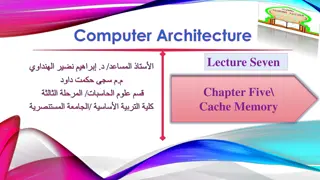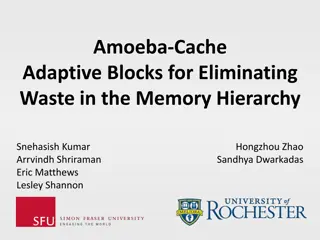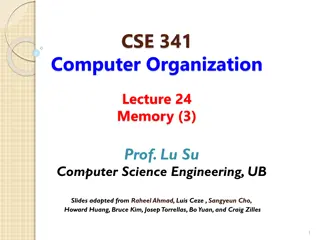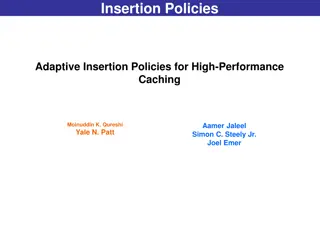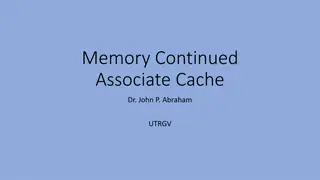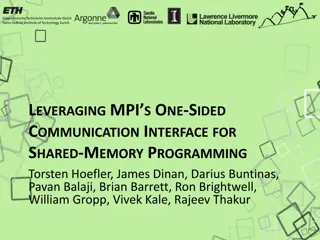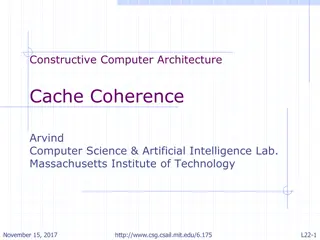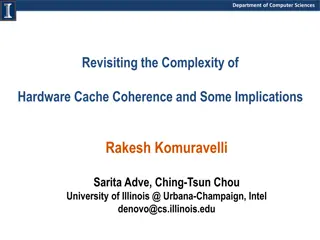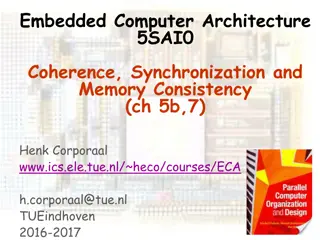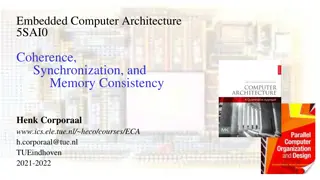Understanding Shared Memory Architectures and Cache Coherence
Shared memory architectures involve multiple CPUs accessing a common memory, leading to challenges like the cache coherence problem. This article delves into different types of shared memory architectures, such as UMA and NUMA, and explores the cache coherence issue and protocols. It also highlights the importance of memory bandwidth and latency in connecting CPUs and memory. Additionally, it discusses bus-based UMA and NUMA shared memory architectures, along with the significance of SMP hardware organizations in the context of shared memory systems.
Download Presentation

Please find below an Image/Link to download the presentation.
The content on the website is provided AS IS for your information and personal use only. It may not be sold, licensed, or shared on other websites without obtaining consent from the author. Download presentation by click this link. If you encounter any issues during the download, it is possible that the publisher has removed the file from their server.
E N D
Presentation Transcript
Shared Memory Architectures Introduce different shared memory architectures Introduce the cache coherence problem and cache coherence protocol.
Shared memory architectures Multiple CPU s (or cores) One memory with a global address space o May have many modules (to increase memory bandwidth) o All CPUs access all memory through the global address space All CPUs can make changes to the shared memory o Changes made by one processor are visible to all other processors. Data parallelism or function parallelism? MIMD
Major issue: How to connect CPU and memory Ideal effect: o Large memory bandwidth o Low memory latency When accessing remote objects, bandwidth and latency are always key metrics. Think of the user experience when downloading small files versus a very large file.
Shared memory architectures: UMA and NUMA One large memory One the same side of the interconnect Mostly Bus Memory references from different CPUs have the same distance (latency) Uniform memory access (UMA) Many small memories Local and remote memory Memory references from different CPUs have different distance to memory location (latency is different) Non-uniform memory access (NUMA)
Bus-based UMA Shared memory architecture Many processors and memory modules connect to the bus oThis architecture dominated in the server domain in the past. Faster processors began to saturate the bus as the bus technology cannot keep up with CPU processing power Bus interconnect may also be replaced by an crossbar interconnect, but that is expensive.
NUMA Shared memory architecture Identical processors, processors have different time for accessing different part of the memory. Memory resides in NUMA domains. The current generation SMPs adopt the NUMA architecture. AMD EPYC multi-chip module (MCM) processor is shown in the left. Memory is distributed to each module.
Cache Coherence Problem Due to the cache copies of the memory, different processors may see the different values of the same memory location. Processors see different values for u after event 3. With a write-back cache, memory may store the stale date.
Bus Snoopy Cache Coherence protocols Memory: centralized with uniform access time and bus interconnect.
Bus Snooping idea Send all requests for data to all processors (through the bus) Processors snoop to see if they have a copy and respond accordingly. oCache listens to both CPU and BUS. oThe state of a cache line may change by (1) CPU memory operation, and (2) bus transaction (remote CPU s memory operation). Requires broadcast since caching information is at processors. oBus is a natural broadcast medium. oBus (centralized medium) also serializes requests.
Types of snoopy bus protocols Write invalidate protocols oWrite to shared data: an invalidate is sent to the bus (all caches snoop and invalidate copies). Write broadcast protocols (typically write through) oWrite to shared data: broadcast on bus, processors snoop and update any copies.
An Example Snoopy Protocol (MSI) Invalidation protocol, write-back cache Each block of memory is in one state o Clean in all caches and up-to-date in memory (shared) o Dirty in exactly one cache (exclusive) o Not in any cache Each cache block is in one state: o Shared: block can be read o Exclusive: cache has only copy, its writable and dirty o Invalid: block contains no data. Read misses: cause all caches to snoop bus (bus transaction) Write to a shared block is treated as misses (needs bus transaction).
MSI cache coherence protocol variations Basic MSI Protocol oThree states: MSI. oCan optimize by refining the states so as to reduce the bus transactions in some cases. Berkeley protocol oFive states, M owned, exclusive, owned shared. MESI protocol (four states) oM modified and Exclusive. MESIF protocol used in Intel processors o MESI + S S and F (Cache should be the responder for a request) MOESI protocol used in AMD processors
Multiple levels of caches Most processors today have on-chip L1 and L2 caches. Transactions on L1 cache are not visible to bus (needs separate snooper for coherence, which would be expensive). Typical solution: oMaintain inclusion property on L1 and L2 cache so that all bus transactions that are relevant to L1 are also relevant to L2: sufficient to only use the L2 controller to snoop the bus. oPropagating transactions for coherence in the hierarchy.
Large share memory multiprocessors The interconnection network is usually not a bus. No broadcast medium cannot snoop. Needs a different kind of cache coherence protocol.
Cache coherence for large SMPs Similar idea as MSI protocol, but the interconnect does not have broadcast. o Use a directory to record where (who the owner is) of each memory line. Use a directory for each cache line to track the state of every block in the cache. o Can also track the state for all memory blocks directory size = O(memory size). Need to used distributed directory o Centralized directory becomes the bottleneck. Who is the central authority for a given cache line? Typically called cc-NUMA multiprocessors
Performance implication of shared memory architecture NUMA architecture can have very large impact on performance Cache coherence protocol can also have impacts o Memory write is even more expensive o False sharing issue One thread s cache behavior can affect other thread s performance
Summary Share memory architectures oUMA and NUMA oBus based systems and interconnect based systems Cache coherence problem Cache coherence protocols oSnoopy bus oDirectory based







